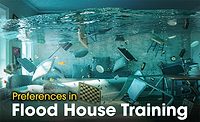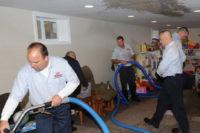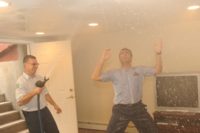Flood House: The Hands-On Training Tool
Since the early 1990s, flood houses have existed as a hands-on tool in some capacity






Sitting in the backroom of a metro-Detroit office building is a 1,000 square foot “house.” Inside, you’ll find the likes of VCT tile, glue-down carpeting, padded carpeting, Berber carpet, vinyl flooring, hardwood flooring and ceramic tile, not to mention wallpaper and drywall. It’s a self-contained house, meaning that there’s running water and electricity. There’s a kitchen, a bathroom, bedrooms and a living area. There’s even a crawlspace.
But what makes this “house” different from your typical house is that about 12 times each year it’s flooded with 1,000 gallons of water. Yes, this “house” is a “flood house,” or a structure that’s built so that it can be purposefully flooded with water in order to train the water damage restoration professionals of tomorrow, as well as insurance professionals, building professionals and facility managers. And while the house located in the backroom at SunGlo Services (Novi, MI) is the only flood house in the state of Michigan, it’s only one of nearly 30 ASD- and IICRC-approved flood houses worldwide.
“(Flood houses) give you the most hands-on experience before entering the field,” says Ryan Meloche, SunGlo Structural Drying Manager, MWR, MTC, MSR. “They help demonstrate all the different scenarios we can create in here. (Flood houses) give you an opportunity to be involved in all these different scenarios and respond accordingly to all these different types of losses using all these different types of equipment.”
The equipment that he’s referring to are the likes of moisture meters, extraction tools, dehumidifiers and more that are used in SunGlo’s Water Damage Restoration Technician (WRT) and Applied Structural Drying (ASD) courses. Getting to know the equipment, Meloche says, is another benefit of the facility. “Before they even get involved in the real world of this industry, they’re able to work with a lot of these tools and kind of formulate their own opinions on things. It helps them be more prepared for when they have to go out and actually do it.”
The house is flooded with water about 24 hours in advance of each class, which, according to Isaac Boussi, SunGlo Services Structural Drying Supervisor, MWR, MTC, MSR, allows students to better “assess the damage or where the water has migrated.” He continues, “What kind of class? What kind of category? Once they assess all that, they extract, map it out, document all the moisture content and make sure it’s set up to our standard to not under-do it and not overdo it.
“We’re not trying to show them our way (of drying), we’re trying to show them the right way.”
Since the early 1990s, flood houses have existed as a hands-on tool in some capacity. While the birth of the training tool is open for debate, many in the industry point to Barry Costa (Costa Group Education) and his portable platform that he packed into crates and shipped to restoration schools across the country. Flood houses have since evolved into full-blown structures - in a way because they have to. In fact, for a flood house to be ASD-approved these days, it has to be at least 1,000 square feet. It’s a little difficult to get that type of size out of a portable platform.
Flood houses have helped move the restoration industry forward in more ways than just training. They’ve given birth to new ideas, new products and new technologies, have helped bridge some of the communication gap between restoration and insurance professionals and have spurred more research in the field.
For a video tour of the SunGlo Services flood house, visit our Video Page.
Looking for a reprint of this article?
From high-res PDFs to custom plaques, order your copy today!











